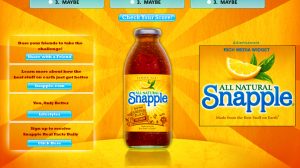
To install StudyMoose App tap and then “Add to Home Screen”
Save to my list
Remove from my list
Snapple’s brand equity was driven by how unique and popular the product became almost immediately. By 1994, it had grown substantially and was known as a popular and user friendly “ready-to-drink” beverage. The huge growth Snapple was able to achieve was due in part to the almost cultish fan base that Snapple developed. For example, a family in New Jersey even gave their son the middle name Snapple. Studies showed that ready-to-drink beverages were selected almost strictly based upon fashion, taste, and status related considerations.
For this reason, Snapple gained appeal through alternative means of marketing.
They used product placements (Seinfeld and Sleepless in Seattle), sponsorship from celebrities, consumer composed jingles, and other alternative means to get consumers to believe they were a fun, innovative, popular and fashionable brand. They used theses sources of marketing to target a younger (18-30), more alternative and “new aged” crowd. Another source of brand equity for Snapple was Wendy “the Snapple Lady. She was a company employee and started by answering consumer letters.
Later, she became the unofficial spokesperson of Snapple. She was featured in commercials reading consumers letters and was really Snapple’s first effort towards giving the brand a (“real people”) personality. This was backed by Snapple’s all-natural ingredients, which helped them gain popularity with health conscious people as well. Although Snapple was good at reaching its target market, its largest disadvantage in the early years was how small their niche was.

In 1994, Snapple was sold to Quaker. Some saw this as a great opportunity for both companies as there were synergies between them.
However, the targeted consumer was changing. The new aged consumers that had previously bought Snapple were getting bored. They began to shift back towards purchasing other read-to-drink beverages. Quaker attempted to respond to its bored consumer, but was too slow to react. Snapple’s reputation began to suffer when it was pointed out that it was less than 10% fruit juice and was merely sweetened water.
Quaker tried to restore sales by distributing Snapple through Gatorade’s channels. Unfortunately for Quaker, the two channels were not compatible. Rather than revamping the strategies Snapple had success with, Quaker moved towards drastic changes. They moved the image too far away from what it originally was which greatly damaged Snapple’s equity. After acquiring Snapple to enter the food and beverage sector, Triarc faced many challenges. Triarc had to reverse sales, revamp the distribution system and create new products that would enable growth.
Most importantly, they had to reconnect the brand with its consumers. Luckily for Triarc, the new-aged consumer was changing again. Companies were coming out with fruit based drinks again (Nantucket Nectar etc. ). Triarc invested heavily in product development and used dynamic marketing strategies to differentiate Snapple from its competitors. Product development was Triarc’s most important move. They developed products such as Whipper Snapple, Sweet Tea, Snapple Farms, Snapple Hydro, and Snapple Elements.
This allowed them to recapture their bored consumer’s attention and boosted their innovation image back to where it once was. Triarc also used grassroots activities and reintroduced Wendy who helped bring back the fun and quirky image of Snapple. Triarc’s marketing strategies were exactly what Snapple needed in an extremely crucial time. Their new products and alternative means of marketing returned Snapple to the success it had once had. In a time of increased competition, Snapple was able to leverage its original brand equity through its core associations of all natural, fun, innovative and quirky.
Cadbury was much smarter than Quaker in their acquisition as well. Cadbury kept Snapple’s management intact, preserved the company’s headquarters and maintained its distribution system. They were not going to make the same mistakes that Quaker made. Cadbury was able to capitalize on the synergies between Snapple and their current products. They were able to use similar distribution, administrative and production systems which allowed them to achieve growth in profits and a 2% boost in the beverage market share.
However, Snapple faced some very different dangers in the Cadbury acquisition compared to the Quaker acquisition. Anytime a small, focused brand like Snapple is acquired by a large corporation, they take on some brand confusion. Consumer’s who love the small and unique company may turn on you when purchased by a large corporation. Because Cadbury is so large, they may dilute the brand by wrongly marketing the product towards a group of consumers much too large for Snapple. Also, large companies tend to have ore standardized marketing efforts. Snapple has always benefitted from alternative means of marketing. For example, Cadbury’s attempt to make Snapple the official beverage of New York did not align with their core associations. As the ready-to-drink beverage market becomes increasingly competitive, Cadbury needs to focus on Snapple’s core associations to leverage its brand equity. If Cadbury doesn’t have the capability to maintain the small niche, unique, innovative, and quirky feel of Snapple, they should sell it.
If they feel they can properly manage Snapple, they need to revisit the alternative means of marketing and use the grassroot activities that Triarc was successful with. They also need to extend the brand into areas that align with the brand’s associations and competencies. With constant consumer boredom, product development and fluctuation of flavors is important. Even Gatorade, one of the most popular ready-to-drink beverages, is constantly expanding upon their line. Cadbury has to keep up with the ever changing consumer in the beverage market while maintaining Snapple’s unique image.
Snapple Case Study. (2020, Jun 02). Retrieved from https://studymoose.com/snapple-case-study-new-essay
👋 Hi! I’m your smart assistant Amy!
Don’t know where to start? Type your requirements and I’ll connect you to an academic expert within 3 minutes.
get help with your assignment